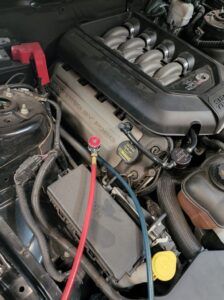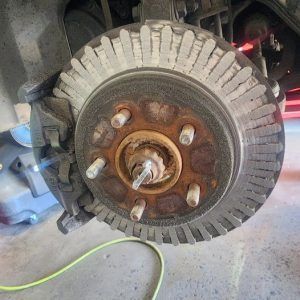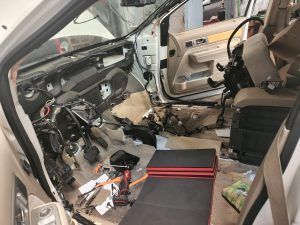Understanding Common Car AC And Heating Repairs
Don’t sweat it! When it comes to your car’s AC and heating system, understanding common repairs can save you time, money, and discomfort. From lack of cold air to strange smells, this article will provide you with the knowledge to tackle these issues head-on.
If you’ve ever experienced a lack of cold air or weak airflow from your car’s AC system, you know how frustrating it can be on a hot summer day. We’ll explain the common causes behind this problem, such as a refrigerant leak or a faulty compressor, and guide you on how to fix it.
Strange smells or odors coming from your car’s vents can be both unpleasant and concerning. We’ll dive into the possible culprits, such as mold or a clogged cabin air filter, and explain the necessary steps to eliminate these odors.
Inconsistent temperature control can make your driving experience uncomfortable, especially during extreme weather conditions. We’ll explore the potential reasons behind this issue, such as a malfunctioning thermostat or a faulty blend door actuator, and provide you with practical solutions.
Noisy or squealing AC systems can indicate a problem that needs attention. We’ll break down the possible causes, like a worn-out fan belt or a failing compressor clutch, and offer you expert advice on how to address these noisy nuisances.
Lastly, if your heater isn’t working properly, we’ll help you troubleshoot the issue. Whether it’s a malfunctioning heater core or a faulty blower motor, we’ll guide you through the necessary repairs to restore warmth to your car’s cabin.
By understanding these common car AC and heating repairs, you’ll have the confidence to tackle these issues on your own or communicate effectively with a professional mechanic. Don’t let AC and heating problems leave you sweating – empower yourself with the knowledge to keep your car comfortable and enjoyable all year round.
Key Takeaways
- Lack of cold air or weak airflow in the car’s AC system can be caused by refrigerant leaks or a faulty compressor.
- Strange smells or odors from the car’s vents may indicate mold or a clogged cabin air filter.
- Regularly checking for mold or mildew in the AC system and cleaning the evaporator can help maintain a mold-free car interior.
- Checking the thermostat, blend door actuator, and refrigerant levels can help resolve inconsistent temperature control in the car’s AC system.
Lack of Cold Air or Weak Airflow
Don’t worry, if you’re not feeling a blast of cold air or strong airflow from your car’s AC, we’ve got you covered. Lack of cold air or weak airflow is a common issue that many car owners face.
The good news is that there are several steps you can take to troubleshoot this problem before seeking professional air conditioning maintenance.
First, check the air filters in your car’s AC system. Over time, these filters can become clogged with dirt and debris, restricting airflow. Simply cleaning or replacing the filters can often solve the problem.
Next, inspect the compressor and condenser. These components are responsible for cooling the air before it enters the cabin. Look for any signs of damage or leaks, as this can cause a lack of cold air. If you notice any issues, it’s best to have a professional technician handle the repairs.
Make sure the AC system is properly charged with refrigerant. A low refrigerant level can result in weak airflow and insufficient cooling. If you suspect a refrigerant leak, it’s important to have it repaired as soon as possible.
Now, let’s move on to the next section about strange smells or odors.
Strange Smells or Odors
If you notice strange smells or odors coming from your car’s AC system, there are a few key points you should check.
First, check for mold or mildew in the system, as these can cause unpleasant odors.
Next, inspect and clean the evaporator, as it can accumulate dirt and debris over time.
Finally, replace or clean the air vents and ducts, as they can also harbor odor-causing bacteria.
By addressing these issues, you can ensure that your car’s AC system smells fresh and clean.
Check for Mold or Mildew in the System
Be sure to regularly check for mold or mildew in your car’s AC and heating system to prevent any potential health hazards. Mold prevention is crucial in maintaining a clean and healthy air conditioning system. To keep your system free from mold and mildew, it’s important to follow proper cleaning techniques.
Here are five steps you can take to prevent mold and mildew growth in your car’s AC and heating system:
- Regularly clean and replace the cabin air filter to prevent the accumulation of dust and moisture.
- Use a mold and mildew cleaner specifically designed for automotive use to effectively eliminate any existing mold or mildew.
- Inspect and clean the air vents and ducts to remove any debris or buildup that could contribute to mold growth.
- Keep your car’s interior clean and dry by regularly vacuuming and removing any excess moisture.
- Use an air purifier or dehumidifier to control humidity levels inside your vehicle.
To ensure the efficiency of your AC and heating system, it’s important to inspect and clean the evaporator. Transitioning into the subsequent section, inspecting and cleaning the evaporator is a vital step in maintaining a mold-free car interior.
Inspect and Clean the Evaporator
Ensure the efficiency and cleanliness of your car’s AC and heating system by inspecting and cleaning the evaporator regularly. The evaporator is a key component of the system that cools the air before it enters the cabin.
Over time, dirt, dust, and debris can accumulate on the evaporator fins, reducing its effectiveness and potentially leading to mold or mildew growth. To clean the evaporator, start by locating it, usually behind the dashboard or under the hood.
Use a soft brush or vacuum cleaner to remove any loose debris. Then, apply a foaming cleaner specifically designed for evaporators and let it sit for a few minutes. Rinse thoroughly with water and allow it to dry completely before reassembling.
Regular evaporator inspections and cleanings not only improve the performance of your AC and heating system but also help prevent unpleasant odors and potential health issues.
Moving on to the next section, it’s important to replace or clean air vents and ducts to ensure optimal airflow.
Replace or Clean Air Vents and Ducts
Upgrading your air vents and ducts is a simple way to enhance airflow and maintain a fresh and comfortable cabin environment. By performing regular air vent maintenance, you can ensure that the air circulating in your car is clean and free from any debris or allergens. Additionally, improving air circulation can help prevent the buildup of moisture, which can lead to mold growth and unpleasant odors.
To give you a better understanding of the components involved, here is a table detailing the different parts of your car’s air vents and ducts:
Component Function Maintenance
Air Vents Allow air to enter the cabin Clean with a soft brush or vacuum
Ducts Distribute air throughout the cabin Inspect for any leaks or blockages
Filters Remove dust and pollutants from the air Replace every 15,000 to 30,000 miles
By keeping these components clean and well-maintained, you can ensure optimal airflow and a comfortable cabin environment. Now, let’s move on to discussing inconsistent temperature control.
Inconsistent Temperature Control
If you’re tired of feeling like you’re stuck in a sauna one minute and an icebox the next, your car’s inconsistent temperature control might be to blame. This issue can make your daily commute a frustrating experience. Luckily, there are some troubleshooting tips you can try to diagnose and resolve the problem.
- Check the thermostat: A faulty thermostat can cause inconsistent temperature control. Make sure it’s set to the desired temperature and functioning properly.
- Inspect the blend door actuator: The blend door actuator is responsible for directing the flow of air through the heating and cooling system. If it’s malfunctioning, it can lead to inconsistent temperature control. Check for any signs of damage or wear and consider replacing it if necessary.
- Check for refrigerant leaks: Low refrigerant levels can cause temperature fluctuations. Inspect the AC system for any signs of leaks, such as oily residue or hissing sounds. If a leak’s detected, it’s important to have it repaired and recharge the system.
These common causes can help you pinpoint the issue with your car’s temperature control. If you’ve resolved the inconsistent temperature problem but are now facing a noisy or squealing AC system, continue reading to find out how to address this issue.
Noisy or Squealing AC System
If you’re experiencing a noisy or squealing AC system in your car, there are a few key points to check.
First, inspect the belt and tensioner to ensure they’re in good condition and properly aligned.
Next, take a look at the AC compressor to see if there are any signs of damage or wear.
Finally, consider lubricating or replacing any moving parts that may be causing the noise.
By addressing these issues, you can restore a quiet and efficient AC system in your vehicle.
Check the Belt and Tensioner
When you first start your car and feel that blast of cold air, you can’t help but feel relieved that your AC belt and tensioner are in good shape. Proper belt maintenance is crucial to ensure the smooth operation of your car’s AC system. Here are four things you should know about belt maintenance and tensioner troubleshooting:
- Regularly inspect the belt for signs of wear and tear, such as cracks or fraying. Replace it if necessary to avoid potential damage to the AC system.
- Check the tensioner to ensure it’s properly adjusted. A loose or tight tensioner can cause the belt to slip or break.
- Listen for any unusual noises coming from the belt or tensioner. Squealing or grinding sounds could indicate a problem that needs attention.
- Consult your car’s manual for specific instructions on belt replacement and tensioner adjustment.
Inspecting the AC compressor is the next step in identifying and resolving any AC system issues.
Inspect the AC Compressor
Now that you’ve checked the belt and tensioner, it’s time to move on to inspecting the AC compressor. This component plays a crucial role in the functioning of your car’s air conditioning system. It is responsible for compressing and circulating the refrigerant, which cools the air before it enters the cabin. Proper maintenance of the AC compressor is essential to ensure optimal performance and prevent costly repairs.
To inspect the AC compressor, start by visually examining it for any signs of damage or leaks. Look for oil stains or debris that may indicate a problem. Additionally, listen for any unusual noises coming from the compressor, such as grinding or squealing sounds. These could be signs of imminent failure.
By regularly inspecting your AC compressor and addressing any issues promptly, you can avoid major problems down the line. Now, let’s move on to the next section about lubricating or replacing moving parts.
Lubricate or Replace Moving Parts
To ensure optimal performance and prevent costly repairs, you should regularly lubricate or replace the moving parts in your car’s AC compressor. Proper lubrication maintenance is essential to keep the compressor running smoothly and efficiently.
Over time, the moving parts in the compressor can wear out or become damaged, affecting the overall performance of the AC system. By lubricating these parts, you can reduce friction and heat buildup, prolonging the lifespan of the compressor. If the moving parts are severely worn or damaged, replacement may be necessary.
It’s important to consult your vehicle’s manual or seek professional help to determine the correct lubrication or replacement procedure for your specific AC compressor model. Neglecting this maintenance can lead to decreased cooling efficiency and potential compressor failure.
Now let’s move on to the next section about why your heater may not be working properly.
Heater Not Working Properly
If your heater isn’t working properly, it’s crucial to address the issue before the colder months arrive. A malfunctioning heater can make driving uncomfortable and even dangerous during winter conditions. To ensure your heater’s in good working order, regular maintenance is essential. Here are some troubleshooting steps to help you identify and resolve heater issues:
- Check the coolant levels: Low coolant levels can cause a lack of heat in the cabin. Make sure the coolant’s at the appropriate level.
- Inspect the thermostat: A faulty thermostat can prevent the heater from working correctly. Test the thermostat and replace if necessary.
- Examine the heater core: A clogged or leaking heater core can lead to inadequate heat output. Inspect the heater core for any signs of damage or blockages.
- Check the blower motor: A malfunctioning blower motor can result in weak or no airflow. Test the motor and replace if needed.
- Inspect the blend door: The blend door controls the mix of hot and cold air. If it’s stuck or broken, the heater may not work properly. Inspect the blend door for any issues.
By following these troubleshooting steps, you can diagnose and resolve common heater issues, ensuring a warm and comfortable driving experience during the colder months.
Frequently Asked Questions
How often should I have my car’s AC system checked or serviced?
You should have your car’s AC system checked or serviced annually to ensure proper functioning. Regular maintenance includes troubleshooting for any issues, cleaning or replacing filters, checking refrigerant levels, and inspecting for leaks.
What could be causing my AC system to blow hot air instead of cold air?
Check the car AC system for common issues like low refrigerant levels, faulty compressor, or clogged condenser. Regular car AC system maintenance, including troubleshooting, can help prevent hot air blowing and ensure optimal cooling performance.
Is it safe to drive my car if I notice strange smells or odors coming from the AC system?
If you notice strange smells or odors coming from your car AC system, it is not safe to drive. These smells could indicate a leak, mold, or other issues that require car AC system maintenance and troubleshooting.
Why does my car’s heater sometimes work and sometimes not?
To troubleshoot car heater problems, start by checking the coolant level and thermostat. If they’re fine, the issue may lie with the heater core or a faulty valve. Regular car heater maintenance can help prevent such problems.
Can a noisy or squealing AC system be a sign of a more serious problem?
A noisy or squealing AC system can indicate a more serious problem. Potential causes include a worn-out belt, a malfunctioning compressor, or low refrigerant levels. Prompt repair is necessary to prevent further damage.
Conclusion
In conclusion, understanding common car AC and heating repairs is crucial for maintaining a comfortable and functional vehicle. If you notice a lack of cold air or weak airflow, it could be due to a refrigerant leak or a faulty compressor.
Strange smells or odors may indicate mold or a clogged air filter.
Inconsistent temperature control could be caused by a malfunctioning thermostat or blend door.
Lastly, a noisy or squealing AC system may be due to a damaged belt or fan motor.
Proper diagnosis and timely repairs are essential to keep your car’s climate control system running smoothly.







